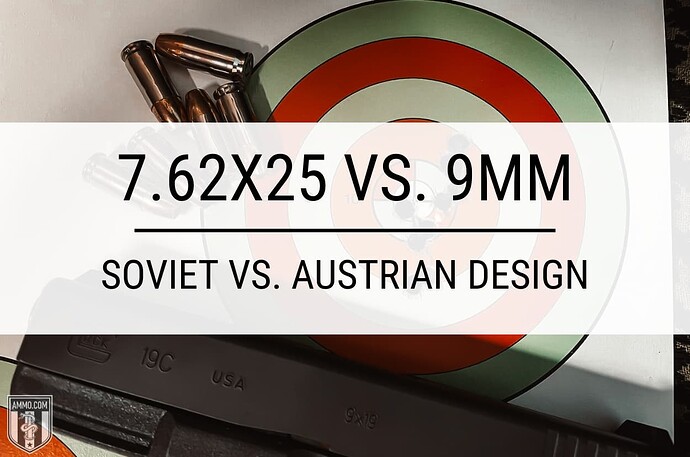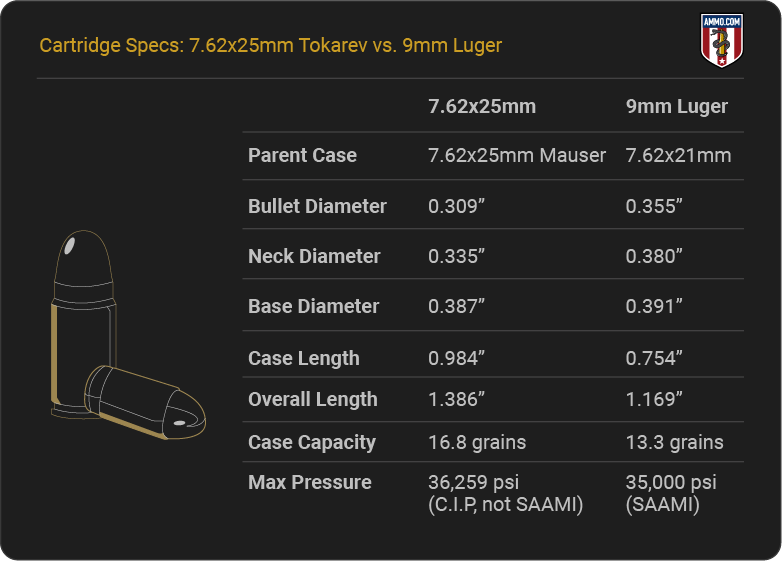The 7.62x25mm Tokarev is a Soviet rimless bottleneck submachine gun and pistol cartridge that entered production in 1930. The Russian military eventually replaced it with the 9x18mm Makarov – but that’s not the 9mm we’re comparing the 7.62x25mm to in this article.
We are talking about the ever-popular 9mm Luger: designed by Georg Luger, an Austrian gunsmith, in 1901. It’s a rimless tapered handgun and submachine gun cartridge that is used by civilians, law enforcement and military organizations worldwide.
Let’s see how the cartridges compare to one another!
Comparing The 7.62x25 to 9mm
Despite having been designed decades apart, these cartridges do share some similarities. We’ll focus on their differences so you can decide which is better for your situation by the end of this article.
We’ll compare and contrast their recoil, accuracy, stopping power, self-defense capabilities, cost and availability, and reloadability. At the end, we’ll tally up the scores and declare a winner for all of time! Okay, it’s admittedly not that dramatic, but you will better understand which round will work better for you.
Technical Specs
You can tell these two rounds apart at a glance. The first noticeable differences are their overall lengths and one is bottlenecked. The 7.62x25 Tokarev is a bottlenecked cartridge with an overall length of 1.386 in, while the 9mm Luger has a shorter length of 1.169 in. The 7.62x25’s extra length comes from its case: 0.984 in, as opposed to 0.754 for the 9mm Luger. Its longer case and same rim diameter naturally means the 7.62x25mm Tokarev cartridge has more case capacity: 16.8 grains H2O versus 13.3 grains H2O for the 9mm Parabellum.
The 9mm Luger fires a larger bullet in diameter and weight. 9mm bullet diameter is 0.355 in and fires a bullet ranging in weight from 90 to 165 grain. The 7.62x25mm bullet diameter is 0.309 in and fires a bullet ranging in weight from 85 to 90 grain.
Now that we know some of the cartridges’ physical differences, let’s discuss how they affect performance in everyday situations.
How Does the Recoil of 7.62x25 Tokarev Compare to That of 9mm Luger Rounds?
It is crucial to take recoil into consideration. A round with heavy recoil will be more challenging to control, and will slow the rate of your follow-up shots. The potential for flinching (which makes you less accurate) is also an issue for heavy-recoil cartridges.
Felt recoil differs from shooter to shooter, and often depends on the firearm, stance, and ammo choice. Free recoil is an objective measure of how much a cartridge kicks based on firearm weight, muzzle velocity, propellant weight, and bullet weight.
Both cartridges are known for having low recoil. The 7.62x25mm Tokarev has about 4.6 ft-lbs of free recoil when you’re firing an 85 grain FMJ at 1,525 fps from a 1.9 lbs pistol. The 9mm Luger has about 4.4 ft-lbs when you’re firing a 115 grain JHP at 1,190 fps from a 2 lbs Glock pistol.
The difference in recoil is so minimal that you won’t be able to sense it when firing the two rounds. Generally, any difference within 1 ft-lbs is incredibly difficult to perceive.
This section is a tie because the difference in recoil is nearly impossible to distinguish.
Accuracy: 9mm vs. 7.62x25
A cartridge’s accuracy depends on many factors, including the firearm, bullet design, shooter, and environmental factors. Recoil and trajectory also play pivotal roles.
Since these cartridges were designed for pistols and submachine guns, we can expect their trajectories to be similar within 25 yards (the distance the average self-defense situation occurs). However, the 7.62x25mm has a much flatter trajectory as we increase the distance to the target.
When sighted in at 25 yards, the 7.26x25mm 85 grain bullet drops only -5.8 in at 100 yards. The 9mm 115 grain bullet drops -9.7 in under the same conditions.
Accuracy will appear identical at close range. As the target moves farther away, the 7.62x25mm Tokarev’s flatter trajectory will significantly facilitate accurate shot placement…
The 7.62x25 wins this section.
Continue reading 7.62x25 vs. 9mm: Soviet vs. Austrian Design on Ammo.com

